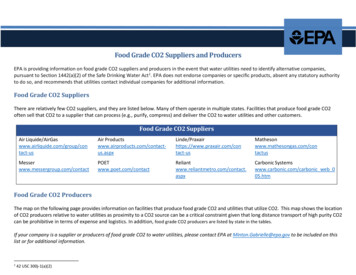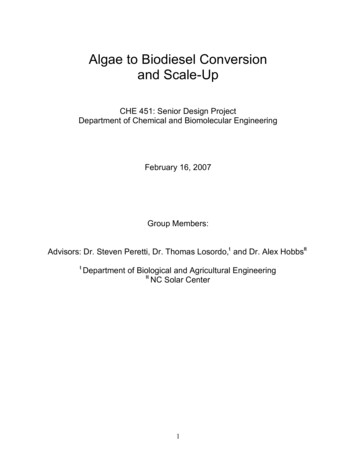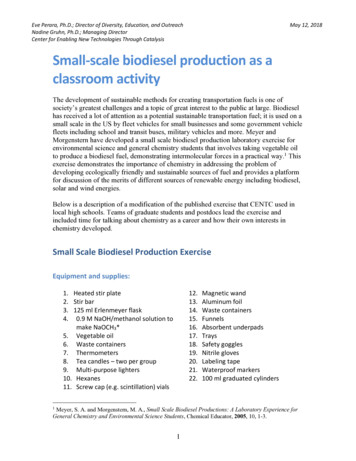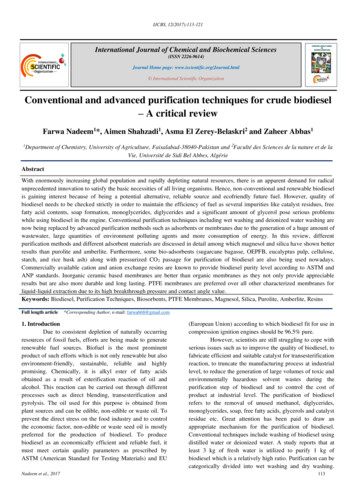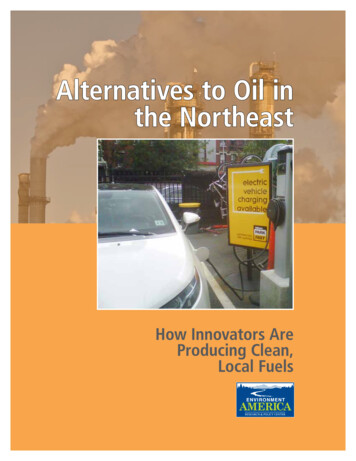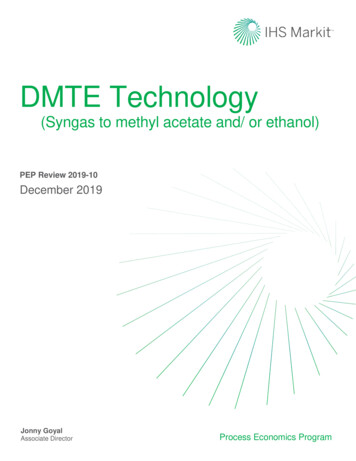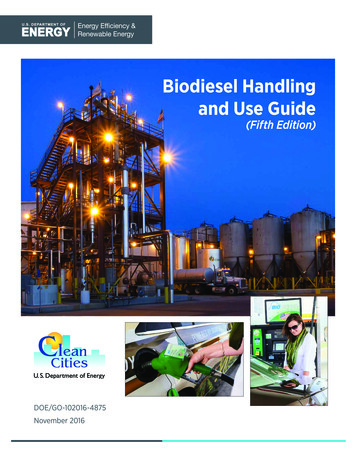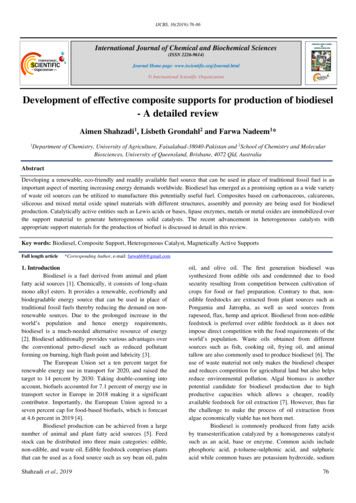
Transcription
Equity Research Industry ReportApril 2010Biofuels OutlookEthanol Margins Improve; BiodieselCapacity Still IdleSam Kanes, CA, CFA – (416) 863-7798Scotia Capital Inc. – CanadaDavid Forster, CA – (416) 863-7846Scotia Capital Inc. – CanadaLisa Wilkinson, MBA, P.Eng. – (416) 863-7077Scotia Capital Inc. – CanadaFertilizers, Biofuels & Chemicals ResearchFor Reg AC Certification and important disclosures see Appendix A of this report.Analysts employed by non-U.S. affiliates are not registered/qualified as research analysts withFINRA in the U.S.
Biofuels OutlookApril 2010ContentsRenewable Food- and Non-Food-Based Fuels2First-Generation Ethanol Margins Improving13Second-Generation Cellulosic Ethanol19E85 Ethanol-Blended Gasoline26Biodiesel27Algae Biofuel Still Very Promising37Biomass47Advanced Biofuels49Bioenergy Conclusions58Appendix 1 – Advanced Biofuels Projects59Appendix 2 – Biofuels Digest Index60Appendix 3 – Algae Companies61Appendix 4 – Algae’s Value Chain62All figures in U.S. dollars unless otherwise stated.1
Fertilizers, Biofuels & ChemicalsApril 2010Renewable Food- and Non-Food-Based FuelsWe separated renewable fuels prospects from our January 2010 Quarterly Fertilizer, Biofuels, andChemicals Outlook into another stand-alone report that, for now, will be semi-annual. Numerous newadvanced biofuel developments continue to be announced. We care particularly about fertilizer demandused for food-based fuels as food-based fuel demand growth was a key reason why fertilizer stockssoared 500%-1,500% between 2003 and mid-2008. Global biofuel production reached 22 billion gallonsin 2009, with 19 billion gallons being ethanol production. In particular, we are interested in the followingCanadian biofuel companies: Biox (just IPO’d with a C 50 million issue), GreenField Ethanol, Lignol,Ensyn, Iogen, and Enerkem (just raised C 53.8 million from Waste Management). All of these companiesspoke at our November 2009 Bioenergy Day Conference.Food Demand for FuelAbout 33% of the incremental 2006-2008 global food demand was used for food for fuel (accordingto Mosaic’s CEO). U.S. corn-based ethanol demand soared as at May 5, 2005, when the U.S. governmentstopped protecting oil and gas refiners and distributors from class action MTBE lawsuit legal liability ifthey continued to spill gasoline containing methanol-based MTBE (methyl tert-butyl ether). Ethanol hadonly 15% market share at that time and MTBE had 85%. Since then ethanol captured most of MTBE’smarket share, which led to ethanol prices spiking from 2/gal to 5/gal. In turn, this led to the surge ofU.S. ethanol IPOs, including Aventine, Pacific Ethanol, and VeraSun. They all went bankrupt in 2009because of weak margins, leverage, and/or poor corn procurement or hedging practices. On March 16,2010, Aventine emerged from bankruptcy.Producers’ mostly corn-based ethanol plants are now running again as margins have improved withApril 2010 corn prices slumping to 3.50/bu from 4.25/bu in late December 2009, with oil still close to 80/bbl. A number of plants have and continue to be sold to others for as low as 25% replacement costnew (Valero bought seven ethanol plants from VeraSun at that price).Biofuel ResearchExhibit 1: Key Drivers of Fertilizer DemandPopulationGrowthIncomeGrowthBiofuelsImproved Diets More GrainsLimited Arable LandUrgent Need for Increased YieldsSolution Increased & Balanced Use of Fertilizer andSource: ICL.2Fertilizer analysts and investors are nowforced to understand the future ofbiofuels if they are to accurately assessthe demand for food and, therefore,fertilizer (Exhibit 1). For more informationon Scotia’s effort to do so, please refer toour January 2009 report titled The Choice ofNext-Generation Biofuels and our November2009 report Biofuels Outlook – ExplosiveGrowth and Development Continue. OurNovember 24, 2009, Bioenergy Day 2009conference featured Canada’s biggestrenewable biofuels and renewable bio-powerplayers. For details, refer to our November2009 conference summary report BioenergyDay 2009 – “Bioenergy Opportunities”.
Biofuels OutlookApril 2010Until 2012, generation one U.S. and Canadian food-based biofuels should still have good growthprospects of about 10%-15% annual growth for 2011 and 2012. This is, however, hugely dependenton the spot unleaded gasoline price differential with the spot corn-based ethanol price. Peak 2005-2008growth levels were 30% per year for ethanol and 60% per year for biodiesel. We and others continueto believe that generation one biofuels may see their growth profiles ease further towards zero as of2012 when the United States caps generation one food for fuel.We have yet to see one statement from or have one interview with an oil and gas company thatsupports food-based biofuels. We believe they are, however, all interested in second-generation, moresustainable fuels. They already support myriad second- and third-generation fuel technologies. Activeoil and gas biofuels leaders include Shell, Chevron, BP, Valero, Petrobras, and, more recently,ExxonMobil. This could negatively weigh on fertilizer-supported food demand for generation onebiofuels, and therefore on fertilizer stock valuations over time.3
Fertilizers, Biofuels & ChemicalsExhibit 2: Ethanol ProductionSource: Hydrocarbon Processing.April 2010Exhibit 2 shows a forecast by HydrocarbonProcessing that the U.S. use of corn-based food forfuel may peak around 2014, and then start todecline. The cap on U.S. food-based ethanol andbiodiesel is still 15 billion gallons per year byJanuary 2012 or about 5 billion bushels of corn/yearfor 14 billion ethanol gallons. After that, the 2007U.S. Energy Bill targets second- and thirdgeneration fuels to add another 21 billion gallonsper year to 36 billion gallons per year by 2022. Sowhat will these fuels be made from, and howmuch fertilizer will they need, if any?Biofuel made from human garbage and human wastewater (algae), dead or living trees, wheat waste, cornwaste, and jatropha trees does not require fertilizer. In the case of algae, no potash is required, but lotsof carbon (CO2), some nitrogen, and a little phosphate are needed if wastewater is not used. Some algaecan clean non-potable water, which could get clean water credits. The question is how much low-hangingbiofuel fruit is there for recycled human waste before some fertilizer will be required for other typesof advanced biofuel production?Biofuels Digest announced in late March 2010 that there are now 67 advanced biofuels projects aiming at2.32 billion gallons of capacity by 2014. Appendix 1 includes a detailed table of advanced biofuels projects.Global Food-For-Fuel DemandGlobal demand for food-based biofuels is forecast to reach 7.2% of food grown in 2010. The InternationalGrains Council assumes 9% of all world vegetable oil consumption will be used for biodiesel, withrapeseed oil accounting for 50%, soy oil for 25%, and palm oil for 12% of biofuel feedstock.In biodiesel politics, the EU charged the United States with dumping its biodiesel into Europe after splashblending it. This cut 2009 U.S. biodiesel production for exports to Europe in half and weighed onU.S. soybean prices through March 2010. The EU has made the commercial development of biofuels apriority in Europe, driven by legislation that targets a 10% use of renewable energy in transportation fuelsby 2020. However, this is not a mandate but a non-enforceable guideline.Biofuel Market PotentialIn 2008, global fuel consumption was 85.43 million barrels per day at a refiner average cost of 2.95trillion (U.S. EIA). The 2008 global biofuels market was only 1.7 million barrels per day, or only 2% ofthe total 2008 fuel market. Royal Dutch Shell has estimated that alternative fuels could grow 500% to10% of global fuel use by 2020, or 300 billion per year of revenue.Four key biofuel drivers are: (1) energy independence; (2) climate change remediation; (3) sustainablegreen economic development; and (4) the search for fuels that are lower in cost or in price volatility.Some biodiesel feedstock will further diversify away from food-based to jatropha in 2013 and algae in2015. Renewable jet biofuel (JP-8) is also expected to emerge as a major new biofuel market because ofsuccessful 2009 testing of algae and jatropha JP-8 blends in a variety of aircraft by a variety of carriers.All generation two (mostly cellulosic ethanol) and three (mostly algae) fuels are targeting sub- 2 pergallon variable cash costs to become competitive. The airline industry has already concluded that 50%blends of algae and jatropha JP-8 jet fuel will be accepted, according to Biofuels Digest.4
Biofuels OutlookApril 2010The ease of drop-in non-food-based fuels into existing fuels heavily favours those that can pass fuel specsand have the same energy density as the fuels they are replacing or blending with. This heavily favoursrenewable biodiesel over renewable ethanol and algae over cellulosic ethanol at this time.CarbonA Canadian study published by the Global Renewable Fuels Alliance concluded that world biofuelsproduction in 2009 reduced global greenhouse gas (GHG) emissions by 123.5 million tonnes, a 57%reduction compared to equivalent petroleum fuels.A recent study published by World Wildlife Fund estimates the adoption of second-generation biofuels in20% of conventional fuels has the potential to reduce emissions by 1 billion tonnes by 2030.Advanced second- and third-generation biofuels are likely to reduce 50% to 75% of GHG emissions.Investment IndexThe Biofuels Digest Index, comprised of 25 advanced and first-generation pure-play biofuel companiesand oil and grain companies with significant biofuel investments and operations, gained 17.48% in 2009.The index outperformed the Dow Jones Industrial, and performed within 2% of the S&P 500 Index(Exhibit 3). The companies comprising the Biofuels Digest Index are included in Appendix 2.Exhibit 3: Biofuels Digest Index vs. S&P 500751200S&P 500701100S&P Index (US )1000605590050800Biofuels Digest Index4570040600Jan-0935Feb-09 Mar-09Apr-09 May-09Jun-09Jul-09Aug-09DateSource: Biofuels Digest.5Sep-09Oct-09Nov-09 Dec-09Jan-10Feb-10 Mar-10Biofuels Digest Index (US )65
Fertilizers, Biofuels & ChemicalsApril 2010Generation One Food-for Fuel-Arguments in FavourMosaic’s estimate that 33% of incremental food demand from 2005 to 2008 was used for generationone biofuels. This created a furor among those negatively affected by soaring food costs. Those infavour argued that only 7.2% of the world’s grains and oilseeds were used for alternative and renewablefuel. However, that is only 3% of the net total world’s food production if one subtracts dried distillergrain and glycerine by-products used mostly to feed animals/poultry/fish. Therefore, the net effect onfood prices by food for fuel should be relatively small.U.S. corn yields for 2009 hit a record 165.2 bushels per acre, up 3% over 2004’s record level. This cornyield improvement is now up over 400% in 40 years. Farmland efficiency using satellite technology,GPS (global positioning system), no-till farming, and genetically modified (GM) seeds have thereforeincreased the value added per acre of corn being converted into ethanol, according to supporters. Also,newer world-scale ethanol plants are raising ethanol yields/bushel towards 3 gallons/bushel versus only2 gallons/bushel in 1980. Water use per ethanol gallon has also dropped sharply over time.Supporters also cite that the Environmental Protection Agency (EPA) has defined corn-based ethanol ashaving a 21% GHG reduction.Biofuels Revenue RisingClean Energy Trends 2010 stated biofuels reached 15 billion in revenue on 23.6 billion gallons of ethanoland diesel production. Their biofuels revenue forecast for 2019 is 112.5 billion.Biofuels M&A Activity RisesIn 2009, there was 1.327 billion in biofuels M&A activity, up over 420% from 2008, making it the fastestgrowing alternative energy sector (Exhibit 4). Biofuels deals fell to 27 transactions in 2009 from 69transactions in 2008.Exhibit 4: 2009 Greentech M&A ActivitySource: Peachtree Green Advisors.6
Biofuels OutlookApril 2010Oil Company Interest in Advanced Biofuels RisingIn 2009, there was a significant increase in multinational companies interested in biofuels, especially oilcompanies. A recent biofuel survey ranked BP (number four), Petrobras (18), Shell (27), ExxonMobil(29), and Chevron (51) in the “2009-2010 Hottest 100 Companies in Bioenergy,” which had thempreviously unranked in 2008-2009. These rankings highlight the speed at which big oil companies areentering the biofuels market.Shell just announced a 12 billion deal in Brazil with sugar-based ethanol partner Cosan. BP hasinvested 1 billion in ethanol expansions to date in Brazil, partnered with DuPont to construct abiobutanol demonstration plant in the United Kingdom, and entered a joint venture with Verenium, acellulosic ethanol producer. Shell is working with Canadian-based Iogen to produce cellulosic ethanolfrom wheat straw, and with Codexis for ethanol-based enzymes. Codexis has filed a prospectus to enterU.S. equity markets.In July 2009, ExxonMobil announced it will invest 600 million in an algae biofuel company withSynthetic Genomics to create genetically modified algae that continually “milk” the oil feedstock (fattyacids). Chevron has a joint venture with Weyerhaeuser to make fuel from biomass (Catchlight) and hasinvested in algae-based fuel producer Solazyme. Valero has also invested in algae, as well as generationone ethanol.Old Non-Renewable Refinery ShutdownsIn October 2009, Sunoco Inc. was the first major oil refiner to announce the shutdown of a U.S.refinery during the 2009 economic downturn, closing its Eagle Point refinery in New Jersey. InNovember 2009, Valero announced its Delaware City refinery was closing. At our Bioenergy DayConference in November 2009, AMEC suggested that bolt-on technology could be used to transformmothballed refineries into biorefineries that can produce biofuel and many other valuable coproducts, while saving jobs. Similar add-on technology is beginning to be used in the ethanol industrywith DuPont-POET, a U.S. ethanol producer, building a front-end processing step to its first-generationethanol plant to produce second generation cellulosic ethanol in Iowa from corn cobs.Government Funding AnnouncementsOf the 787 billion U.S. stimulus package, 100 billion will go to clean technology investments,including biofuels.In March 2010, in Washington, the Renewable Fuels Reinvestment Act was introduced, proposing anextension of the 0.45 Volumetric Ethanol Excise Tax Credit, the 0.54 tariff on imported ethanol untilDecember 31, 2015, and the 0.56 Small Producers Tax Credit and the Cellulosic Ethanol Production TaxCredit to January 1, 2016. These tax credits are scheduled to expire on December 31, 2010.On October 27, 2009, U.S. Secretary of Energy Steven Chu announced that the DOE’s AdvancedResearch Projects Agency-Energy (ARPA-E) awarded 151 million in funding for over 37 biofuel-relatedprojects. Agrivida was awarded 4.6 million for on-cell-wall-degrading enzymes grown within the plantitself that are activated after harvest. This could dramatically reduce the cost of cellulosic biofuelsfeedstock processing. Ceres was awarded 5 million for its research on genes that enable energy crops toproduce more biomass using less (lower quality) land, less water, and less fertilizer than conventionalenergy crops. DuPont was awarded 9 million for its project producing biobutanol from seaweed.7
Fertilizers, Biofuels & ChemicalsApril 2010In December 2009, the ARPA-E opened its second funding application period with 100 million availablefor projects focusing on using microorganisms to convert CO2 into fuel, carbon capture technologies, andbattery technologies that would allow electric vehicles to compete with gasoline-powered cars and trucks.In November 2009, the United States Department of Agriculture (USDA) and the Department of Energy(DOE) announced 24 million in bioenergy and bio-based products research and development (R&D)grants. GE Global Research was awarded 1.6 million to develop detailed kinetic models of biomassgasification. Gevo Inc. was awarded 1.78 million to develop a yeast fermentation organism that couldcost-effectively convert cellulosic material into isobutanol.In December 2009, the DOE announced 564 million in funding for 19 integrated biorefinery projects.Over 85% of the announced funding will go to 14 pilot-scale and four demonstration scale biorefineryprojects in the United States. The remaining will focus on accelerating the construction of previouslyfunded biorefinery projects. The DOE award is to be matched by over 700 million in private funding fora total investment of 1.26 billion. Algenol Biofuels received 25 million for its algae-to-biofuelsproject with Dow in Texas.Exhibit 5: Biofuel Investments by Country, 2009BrazilU.S.Papua New GuineaCanadaIndiaRwandaPhilippinesSouth AfricaEthiopiaAustraliaSwedenKenyaArgentinaSouth KoreaPeruMosambiquePoland 3,454 2,010 800 589 438 250 197 190 84 75 73 46 37 18 12 10 illionmillionmillionTotal 8,287 millionSource: Biofuels Digest.Globally, in 2009 8.7 billion in biofuel investmentswere announced based on data from 18 countries(Exhibit 5). Overall, Brazil led with 3.5 billionfollowed by the United States with 2.3 billion.The largest reported investments were a 2.8 billionmulti-year program for ethanol and biodieselexpansion by Brazil’s Petrobras and a 600 millioninvestment by ExxonMobil in algal-based fuels.In October 2009, Canada announced it would investC 1.5 billion over nine years through theecoENERGY for Biofuels program. The program isinvesting C 110 million in Suncor Energy’s St. Clairplant to strengthen the Canadian renewable fuelindustry. Canada’s Economic Action Plan alsodedicates C 1 billion to the Clean Energy Fund andC 1 billion for the Green Infrastructure Fund.The U.S. government will provide an additional 5billion in tax credits to encourage new manufacturingassociated with renewable energy sources.Biofuels Impact on Water SuppliesHuman-required fresh water plays an important role in food-for-fuel production. About 70% of theworld’s water use is for food. As global demand for water increases, the effects of water use in biofuelproduction needs to be considered. Corn is a resource-intensive crop that requires some irrigated watersupply to grow in parts of North America. NextExhibit 6: Water Requirements for Biofuelsgeneration feedstocks, such as algae, do not strain thewater supply as much as first-generation crops, asWater Requirementalgae can grow effectively in most wastewater. Aper Litre of ProductU.S. study on water resources required to produceCorn-based Ethanol3-4 Lbiofuels found that corn-based ethanol used theCellulosic Ethanol2-6 LBiodiesel1Llargest amount of water per litre of ethanolproduced while biodiesel required the leastGasoline1-2 Lamount of water (Exhibit 6).Source: U.S. Government Accountability Office.8
Biofuels OutlookApril 2010POET is expected to cut water consumption down to 2.33 gallons from three gallons of water per gallon ofethanol through the introduction of a proprietary cooling water recycling system. The company istargeting a 22% reduction in water consumption over the next five years. POET’s current water usage rateof three gallons of water per gallon of ethanol is 80% less than the water usage when its operations startedin 1988.Low Carbon Fuel Standards (LCFS)LCFS are performance measures based on the total amount of carbon emitted per unit of fuel energy,including all the carbon emitted in the production, transportation, and use of the fuel. California hasenacted into law a LCFS for 2020. Each company is assigned a maximum level of GHG emissions perunit of fuel energy it produces. The level declines each year to put the country on a path to reducing totalemissions. LCFS allow for the trading of emission credits among fuel suppliers. LCFS are consideredthe most practical way to begin the transition to alternative fuels.Downside of LCFS renewable fuel standards: (1) it only targets biofuels and not other alternatives; and(2) prevents the innovation of other low carbon technologies.Downside of carbon taxes: (1) they attract political opposition and public anger; and (2) have limitedeffectiveness. For example, a tax of 25/ton of CO2 would increase the retail price of electricity from coalby 17%, enough to motivate electricity producers to find low-carbon alternatives. However, a tax of 50/ton CO2 would raise the price of gasoline by only 45 cents per gallon. This wouldn’t be enough toinduce drivers to switch to low-carbon fuel alternatives.Downside of carbon cap and trade. Refiners would likely increase the price of fuel to subsidize lowcarbon fuels. This would cause consumers to drive less and auto companies would produce more fuelefficient vehicles.To be more effective, LCFS must be coupled with other policies including: (1) efficiency and GHGemission standards for new cars, (2) infrastructure to support alternative fuels, and/or (3) incentives toreduce driving & promote transportation alternatives.Design of LCFS. Three models could be included in the standards. (1) refiners can blend biofuels fromcellulose or waste into gasoline and diesel, (2) refiners can buy natural gas, biofuels, electricity, andhydrogen, and (3) refiners can buy credits from other refiners or use banked credits from previous years.Implementing LCFS: The LCFS process will require a system to record and verify GHG emission levels.One suggested approach involves “default and opt-in” where fuels are assigned a default value. The fuelproducer can accept the default value or provide evidence it can produce significantly lower emissions.This places the burden of measuring and certifying GHG emissions on the oil distributors, biofuelproducers, and electricity generators.LCFS challenges: (1) Companies will often look for the easiest way to respond to LCFS requirements,which could involve shuffling production and sales in a way that meets the requirements of the LCFSbut do not actually result in any net change; and (2) Indirect land-use changes – scientific studieshave not yet quantified the indirect land-use effect of biofuels. Preliminary analysis suggests theramp up of corn ethanol for the RFS targets will add 40% more GHG emissions per unit of energy.Cellulosic fuels would have a smaller effect. Biomass (crop and forestry residue and urban waste)would likely have no effect.9
Fertilizers, Biofuels & ChemicalsApril 2010LCFS is more effective at the national level, or even at the international level. Efforts are ongoing in theEU to complement its biofuel directive with an LCFS standard that would require a 10% reduction inGHG intensity by 2020 for transport fuels.In February 2010, the National Petrochemical & Refiners Association, American TruckingAssociations, and other industry groups filed a lawsuit against the California Air Resources Board(CARB) for its LCFS. The suit claims the LCFS regulates interstate and foreign commerce bydiscouraging the use of Canadian crude oil and ethanol produced in the American Midwest,violating the commerce clause of the U.S. Constitution. Two other lawsuits against CARB over itsLCFS have been filed by the ethanol industry.U.S. Renewable Fuel Standard 2 (RFS-2)On February 3, 2010, the United States reconfirmed its commitment to its Renewable Fuel Standard 2(RFS-2) goals with energy policies that promote the production and use of biofuels. The EPA set 2010blending volume targets for cellulosic ethanol at only 6.5 million gallons (as that is all the capacity thatwas built), significantly lower than the 100 million gallons proposed in May 2009. Biodiesel blendingvolume was increased to 1.15 billion gallons as the EPA combined the 2009 biodiesel volume requirement(0.5 billion gallons) and the previously proposed 2010 biodiesel volume requirement (0.65 billion gallons)and made the consolidated requirement mandatory. Soybean oil prices increased 12% in response. Thetotal 2010 RFS volume was maintained at 12.95 billion gallons, increasing to 36 billion gallons in 2022.Over the next 12 years the annual volume requirements under RFS-2 increase to 36 billion gallons from13 billion gallons. The program has been expanded from RFS-1 to include off-road, locomotive, andmarine gasoline and diesel fuel.The RFS-2 mandates the compulsory purchase of four types of fuel rather than the single fuel as underRFS-1. The four types of fuels are: (1) cellulosic biofuels, including at least a 60% GHG reduction;(2) biomass-based diesel, including at least a 50% GHG reduction; (3) advanced biofuels, including atleast a 50% GHG reduction; and (4) other renewable fuels, including at least a 20% GHG reduction.A major part of the RFS-2 program is the requirement that the lifecycle GHG emissions of qualifyingrenewable fuels must be less than the GHG levels of the 2005 baseline average gasoline or dieselfuel it replaces. The threshold for cellulosic biofuel is 60%, and the threshold for advanced biofuel andbiodiesel is 50%. In February 2009, the EPA determined that biodiesel made from soy, waste oil, fats,and greases complies with the 50% GHG threshold, allowing biodiesel to qualify for use under federalbiofuels mandates.The EPA retained its Renewable Identification Numbers (RINs) system of compliance under RFS-1 totrack transactions. With the introduction of new fuels under RFS-2, there are now multiple types of RINsto correspond to the new types of fuels.According to a white paper on the RFS-2 by Stoel Rives, one of the most dramatic changes under RFS-2 isthe requirement that all qualifying renewable fuels be produced with renewable biomass. Renewablebiomass includes: crops harvested from existing agricultural land, planted trees from a tree plantation onnon-federal land, animal waste material, animal by-products, forestry residue, biomass, algae, andseparated yard waste or food waste.Stoel Rives’ white paper mentioned that one point of criticism on RFS-2 by some industry participantswas the limited recognition of municipal solid waste (MSW) under the Proposed Rule. The EPA resolvedthese issues in the Final Rule by allowing certain portions of MSW to be included as renewable biomass,provided that separation has occurred first.10
Biofuels OutlookApril 2010The white paper also lists a key constraint with the RFS-2 is the requirement that all parties must registerwith the EPA prior to participating in the mandatory RIN program. The registration process must becompleted by July 1, 2010, and could be the main constraint as the EPA implements the RFS-2.Q4/09 & Q1/10 Biofuel DevelopmentsOn March 2, 2010, the U.S. DOE announced 100 million in Recovery Act funding to be made availableto accelerate innovation in green technology. The funding was not directed at specific projects. This is theDOE’s third round of funding for the Advanced Research Project’s Agency-Energy (ARPA-E).In December 2009, the U.S. Treasury Department initiated a project to determine the economic andenvironmental impacts of increasing biofuel production. The study will include an analysis of theincremental impact of additional biofuel production on U.S. grain crops, forest products, and fossil fuels,including the impact on prices.In February 2010, the New York Times reported that the U.S Senate might put forward an energy andclimate bill, which is more likely to pass the Senate than cap-and-trade legislation. The bill that is likely toemerge would include support for the development of nuclear and clean coal, which would help achievethe U.S. goal of reducing emissions by 17% from 2005 levels by 2050. There is some support for a carboncap and dividend proposal.The U.S. 2011 fiscal budget proposal released on February 1, 2010, included tax breaks for the domesticoil, natural gas, and coal industries. At the same time, the Obama administration proposed over 1 billionin new funding for fossil fuel R&D, including 668 million for the DOE “Clean Coal Power Initiative,”which aims to develop and commercialize new environmental technologies for the coal industry.On December 24, 2009 India reinstated its 20% blending target of biofuels in diesel and ethanol by2017, along with financial incentives for second generation biofuels, including a national biofuelfund. The auto industry is booming in India as it is in China. All new cars in India are capable ofrunning 20% ethanol blends.The Health Care Bill passed in the U.S. House included: (1) an amendment to the term “qualifiedfeedstock” for the 1.01/gallon cellulosic ethanol producer credit to include any lignocellulosic orhemicellulosic matter that is renewable, and any cultivated algae, cyanobacteria, or lemma; and (2)the removal of a 24 billion biofuel tax credit used by pulp and paper firms that recognizes black liquor asa biofuel, rather than as a biofuel feedstock. The biofuels provision in the bill is viewed as a positive forthe non-pulp and paper biofuel industry, supporting more cellulosic and algae biofuel production.The House passed the Waxman-Markey Climate Change Bill that the Senate has delayed its draft 950page bill until later in 2010. In 2009, the U.S. government increased funding to the DOE’s Office ofScience by 18% to 4.76 billion to help advanced biofuels research. An additional 1.6 billion wasallocated from stimulus spending to develop new electricity sources, more efficient cars, and to addressclimate change through renewable fuels.Selected Q3/09 Biofuel DevelopmentsASTM International’s aviations fuels committee approved the use of a 50/50 biofuel blend foraircraft. The airline industry is now looking for subsidies and allowances to be granted, as a result of theAmerican Clean Energy and Security Act of 2009, to off
U.S. ethanol IPOs, including Aventine, Pacific Ethanol, and VeraSun. They all went bankrupt in 2009 because of weak margins, leverage, and/or poor corn procurement or hedging practices. On March 16, 2010, Aventine emerged from bankruptcy. Producers' mostly corn-based ethanol plants are now running again as margins have improved with
